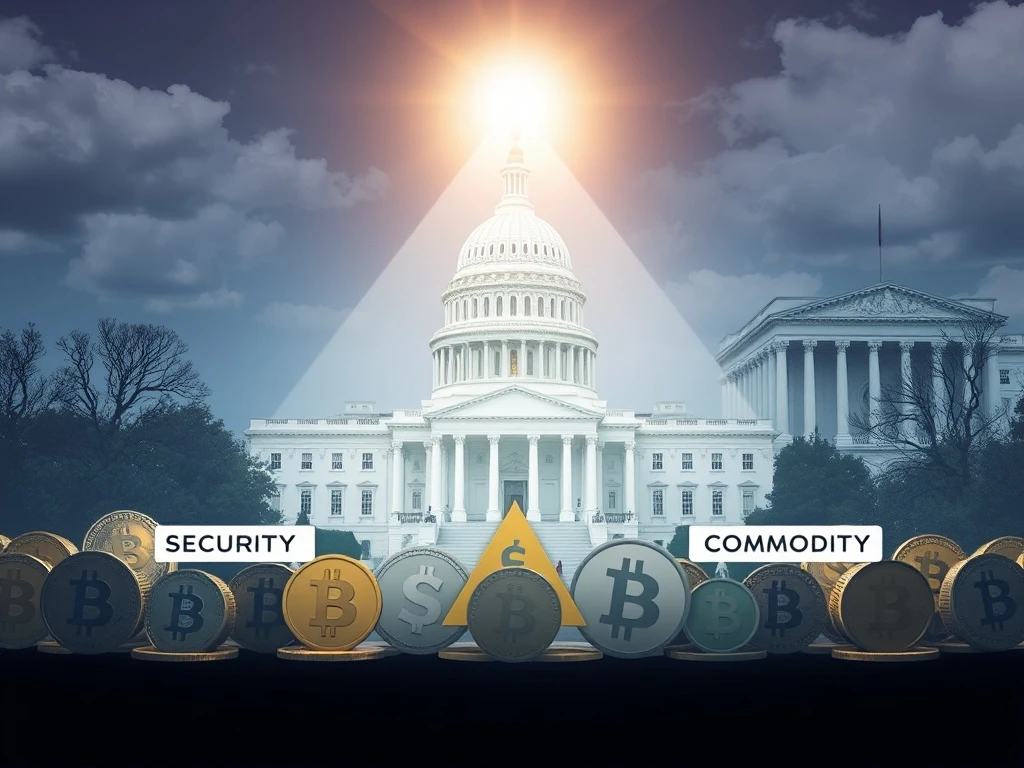Crypto Regulation: Michael Saylor’s Urgent Call for Clarity in US Digital Asset Law

The cryptocurrency world often feels like the Wild West, with innovation outstripping clear rules. This regulatory ambiguity creates challenges for businesses and investors alike. Now, a prominent voice in the industry, Michael Saylor of MicroStrategy, is adding his weight to the growing chorus demanding clear crypto regulation from US authorities. His recent statements highlight a critical need for defined legal boundaries that could unlock the next wave of digital asset innovation.
Why is Crypto Regulation Clarity So Crucial Now?
The current state of affairs in the US crypto landscape is marked by significant uncertainty. For years, businesses have navigated a complex environment where the legal status of various digital assets remains largely undefined. Michael Saylor articulated this pressing concern during MicroStrategy’s second-quarter earnings call. He emphasized the necessity for authorities to “nail down the digital assets taxonomy.”
This includes answering fundamental questions:
- What exactly constitutes a digital security?
- What defines a digital commodity?
- Under what specific circumstances is it permissible to tokenize a security?
- How do we differentiate an asset without an issuer versus a digital token?
The absence of these clear definitions creates confusion regarding who can issue what, and under which conditions, hindering growth and fostering ongoing legal battles, particularly with the Securities and Exchange Commission (SEC).
Collaborative Efforts to Define Digital Assets
The call for clarity is not falling on deaf ears. Various arms of the US government are actively engaging with the challenge of defining digital assets. On Wednesday, the White House Working Group on Digital Asset Markets urged federal regulators to expedite the clarification of crypto rules concerning custody, trading, registration, and record-keeping.
Adding to this momentum, Securities and Exchange Commission Chair Paul Atkins, in a recent speech, acknowledged that much of the innovation in tokenization is occurring offshore, primarily due to existing regulatory hurdles in the US. However, Atkins also revealed a positive shift: companies are approaching the SEC with requests to tokenize assets, and he has instructed SEC staff to “provide relief where appropriate.” This indicates a willingness within the SEC to adapt and ensure the US remains competitive as the digital asset industry evolves. Furthermore, the SEC has established a Crypto Task Force specifically to address and resolve these uncertainties.
Tokenization: A Game-Changer for Access and Efficiency
One of the most transformative aspects of the digital asset revolution is tokenization, the process of representing real-world assets on a blockchain. This technology holds immense promise for democratizing access to various markets. Robinhood, a major player in the investment space, is making significant bets on this trend, particularly aiming to unlock private market access for everyday US investors.
According to Robinhood CEO Vladimir Tenev, “Private markets and related real-world assets are opportunities that don’t exist up until now.” Robinhood is actively collaborating with regulators to make this vision a reality. For instance, the company has already issued private equity tokens in Europe, mirroring shares of companies like OpenAI and SpaceX. While promising, the path to widespread tokenization is not without its challenges, as evidenced by a recent legal inquiry in Lithuania concerning Robinhood’s offerings and OpenAI’s clarification regarding its tokenized shares. These instances underscore the need for the very regulatory clarity Saylor and others advocate.
The Quest for SEC Clarity: Navigating Regulatory Pathways
The Securities and Exchange Commission (SEC) stands at the forefront of the debate surrounding SEC clarity for digital assets. The agency’s approach has often been criticized for relying on enforcement actions rather than clear guidelines. However, recent developments suggest a potential shift. The formation of the SEC’s Crypto Task Force is a step towards systematically addressing the ambiguities that have plagued the industry.
The proposed Digital Asset Market Clarity Act of 2025, slated for review in September, is another pivotal piece of the puzzle. Michael Saylor believes this bill could establish a “very rich framework” for the crypto industry, extending its benefits to traditional businesses looking to issue, trade, or tokenize assets on-chain. This legislative effort aims to provide the explicit definitions and operational guidelines that the market desperately needs, moving beyond the current piecemeal approach to regulation.
Michael Saylor’s Vision: Empowering the Future of Business
Michael Saylor, a long-time advocate for Bitcoin and digital assets, envisions a future where the tokenization of assets is not just for crypto natives but for every business. His aspiration is ambitious yet practical: “In the ideal world, 40,000,000 businesses would be able to issue a token in four hours for $40.” This vision underscores the potential for blockchain technology to streamline operations, reduce costs, and enhance accessibility for a vast array of enterprises.
Such a framework would empower small and medium-sized businesses to leverage blockchain for capital formation, supply chain management, and enhanced customer engagement, fostering unprecedented economic growth and innovation within the US and globally. Saylor’s perspective highlights that clear crypto regulation isn’t about stifling innovation but about creating a stable, predictable environment where it can truly flourish.
Conclusion: A New Dawn for Digital Assets?
The push for clear crypto regulation in the US is reaching a critical juncture. With influential figures like Michael Saylor leading the charge, combined with active engagement from the White House, SEC, and Congress, there’s a tangible movement towards establishing a robust legal framework for digital assets. The potential of tokenization to revolutionize finance and empower businesses is immense, but it hinges on achieving comprehensive SEC clarity. While challenges remain, the collective efforts to define digital securities and commodities, and to clarify the rules around on-chain asset issuance, promise a future where innovation can thrive within a predictable and secure regulatory environment. This evolving landscape could soon transform how businesses operate and how individuals access financial opportunities, marking a significant step forward for the entire digital economy.







